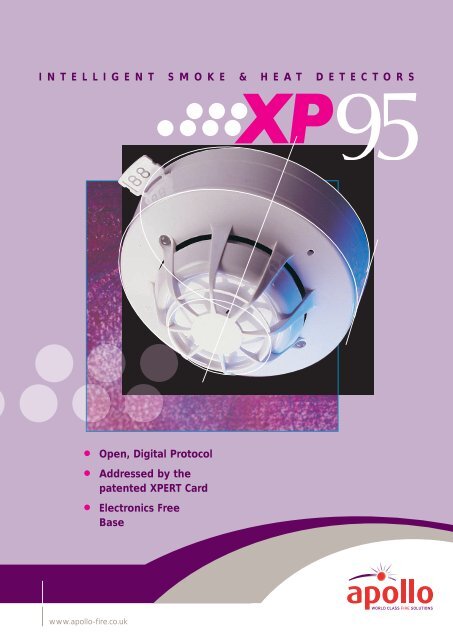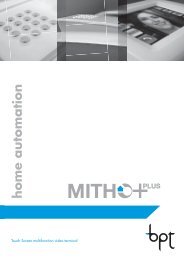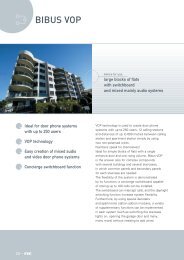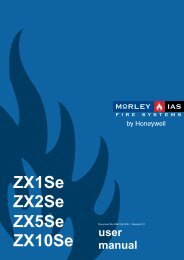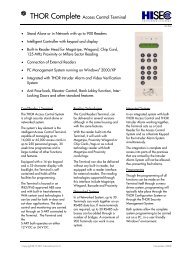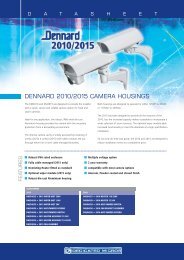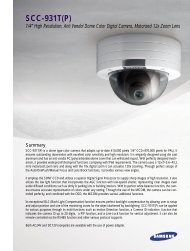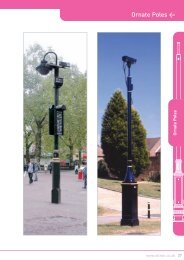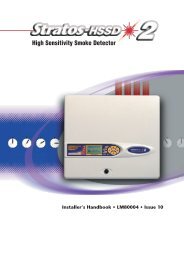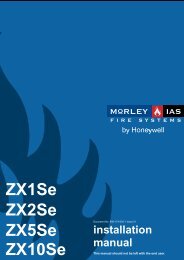Addressable - Norm Teknik
Addressable - Norm Teknik
Addressable - Norm Teknik
Create successful ePaper yourself
Turn your PDF publications into a flip-book with our unique Google optimized e-Paper software.
I N T E L L I G E N T S M O K E & H E A T D E T E C T O R S<br />
●<br />
●<br />
●<br />
Open, Digital Protocol<br />
Addressed by the<br />
patented XPERT Card<br />
Electronics Free<br />
Base<br />
www.apollo-fire.co.uk
●<br />
●<br />
●<br />
●<br />
XP95 SMOKE AND HEAT DETECTORS<br />
The XP95 range has an elegant, unobtrusive<br />
design, finished in pure white polycarbonate<br />
●<br />
●<br />
●<br />
●<br />
●<br />
●<br />
●<br />
Alarm Flag for fast<br />
alarm reporting<br />
Alarm Address for fast<br />
location of alarm<br />
Automatic addressing<br />
with the patented<br />
XPERT card<br />
Electronics free base<br />
Slide-easy base<br />
Ease of installation<br />
Elegant design<br />
Intelligent Smoke<br />
& Heat Detectors<br />
The XP95 range of intelligent fire detectors<br />
is advanced in design, improved in<br />
performance and has unique features that<br />
benefit the installer and end user.<br />
Apollo has always used an open, digital<br />
protocol which has remained basically<br />
unchanged since its inception in 1986. An<br />
open protocol allows freedom of choice for<br />
the fire system specifier, installer and end<br />
user. A system using a digital protocol<br />
is also much less susceptible to corruption<br />
than an analogue protocol and is therefore<br />
often preferred in a system which is<br />
life critical.<br />
XP95 detectors have been carefully<br />
researched and developed by the Apollo<br />
design team and the range has undergone<br />
rigorous testing to ensure that it meets not<br />
only European and other standards but also<br />
the demands of today’s high technology<br />
environments.<br />
A unique, patented address mechanism,<br />
the XPERT card, ensures that the address<br />
data is stored in the base while keeping<br />
the base free of electronic parts that could<br />
be damaged during installation.<br />
Apollo’s XP95 intelligent system is<br />
compatible with a wide range of control<br />
panels. For more information on<br />
compatible panels, please refer to<br />
Apollo publication PP1010 or visit<br />
www.apollo-fire.co.uk<br />
▲ XP95 Ionisation Smoke Detector<br />
The air in the dual chambers of the XP95<br />
ionisation smoke detector is irradiated to<br />
produce ions that travel to the positive and<br />
negative electrodes and hence create a<br />
current flow in the chambers. Smoke<br />
entering the outer chamber causes a drop<br />
in the current flow and an increase in the<br />
voltage measured at the junction<br />
between the outer and inner chambers.<br />
The analogue voltage signal produced in<br />
the sensing chamber is converted to a<br />
digital signal by the electronic circuitry and<br />
transmitted to the control equipment on<br />
interrogation. The micro-processor in the<br />
control equipment then compares the<br />
signal with the stored data and initiates<br />
a pre-alarm or fire alarm as smoke density<br />
increases. When the equipment<br />
determines that a fire condition exists,<br />
it instructs the detector to switch on its<br />
indicator LED and the pre-planned alarm<br />
routine is initiated.<br />
Part no. 55000-500<br />
▼ XP95 Optical Detector<br />
The XP95 optical smoke detector uses an<br />
internal pulsing LED and a photo-diode at<br />
an obtuse angle. In clear air conditions the<br />
photo-diode in the XP95 detector receives<br />
no light from the LED and produces a<br />
corresponding analogue signal. The<br />
signal increases when smoke enters the<br />
chamber and light is scattered onto the<br />
photo-diode. The signal is processed by<br />
the electronic circuitry and transmitted to<br />
the control equipment in exactly the same<br />
way as in the case of the ionisation smoke<br />
detector.<br />
The optical smoke detector is externally<br />
identical to the ionisation detector but is<br />
distinguished by having a clear indicator LED<br />
which emits red light when the detector<br />
is in alarm.<br />
Part no. 55000-600<br />
▼ XP95 Heat Detector<br />
The XP95 heat detector is distinguishable<br />
from the smoke detectors by its low<br />
air-flow resistance case which allows<br />
good contact between the sensing<br />
thermistor and the surrounding air.<br />
The device monitors temperature by<br />
using a single thermistor network which<br />
provides a voltage output proportional<br />
to the external air temperature.<br />
The voltage signal is processed and<br />
transmitted to the control equipment<br />
in exactly the same way as in the case<br />
of the ionisation smoke detector.<br />
A heat detector for use in ambient safe<br />
temperatures of up to 50°C and which<br />
reaches the alarm level at 90°C is also<br />
available.<br />
Part no. 55000-400 (standard)<br />
55000-401 (high temperature)<br />
▼ XP95 Multisensor Detector<br />
The XP95 Multisensor detector<br />
combines inputs from optical and heat<br />
sensors and processes them using a<br />
sophisticated algorithm. It is designed to<br />
be sensitive to a wide range of fires and<br />
may be used in place of an ionisation<br />
detector in many instances.<br />
The detector’s construction is similar to<br />
that of the optical detector but uses a<br />
different lid and optical mouldings to<br />
accommodate the thermistor temperature<br />
sensor.<br />
Part no. 55000-885<br />
For more information on these<br />
detectors, please refer to Apollo<br />
publication, PP1039
▼ XP95 Beam Detector<br />
XP95 beam detectors are designed to<br />
protect large open spaces such as<br />
museums, churches, and warehouses.<br />
Two versions are available: one<br />
comprises a separate transmitter and<br />
receiver plus an interface to the loop; the<br />
other is a reflecting version which has the<br />
transmitter and receiver in one unit. Both<br />
versions are loop-powered.<br />
For more information, please refer to Apollo<br />
publication, PP2078<br />
Part nos.<br />
55000-265 (end to end)<br />
55000-268 (50m)<br />
55000-273 (100m)<br />
▲ XP95 Dual IR Flame Detector<br />
The XP95 flame detector is designed for<br />
use in areas where flaming fires may be<br />
expected and is sensitive to low-frequency,<br />
flickering infra-red radiation emitted by<br />
flames during combustion.<br />
The XP95 flame detector is loop-powered<br />
and requires no external supply. It<br />
communicates with the control panel<br />
using either the XP95 or Discovery<br />
open, digital protocol.<br />
For more information, please refer to Apollo<br />
publication, PP2111<br />
Part no. 55000-280<br />
Please note, the flame detector is not<br />
supplied with a bracket<br />
Bracket Part no. 29600-203<br />
▲ Intrinsically Safe Detector<br />
XP95 Intrinsically Safe (IS) detectors<br />
include all the benefits of the standard<br />
XP95 range, but are developed<br />
specifically for use in hazardous areas.<br />
This range includes ionisation and optical<br />
smoke detectors, heat detectors and<br />
manual call points, BASEEFA<br />
approved to E EX ia IIC T5.<br />
XP95 IS detectors, manual call points and<br />
short circuit isolators are approved by a<br />
number of marine classification societies.<br />
These include the American Bureau of<br />
Shipping (ABS), Bureau Veritas (BV), Det<br />
Norske Veritas (DNV), Germanischer Lloyd,<br />
Lloyd’s Register of Shipping, and the<br />
Maritime and Coastguard Agency (MCA).<br />
For more information, please refer to<br />
Apollo publications PP1094 and PP1095.<br />
▼ Sounders, Beacons & Sounder<br />
Beacons<br />
There is a wide choice of devices for<br />
audible and visual alarm signalling.<br />
Sounders and beacons are available<br />
separately and as a combined sounder<br />
beacon unit.<br />
For more information, please refer to Apollo<br />
publication PP2082 for XP95 100dB Loop<br />
Sounder.<br />
Part no. 55000-278 100dB Loop Sounder<br />
▲ XP95 Manual Call Point<br />
When activated, the XP95 manual call<br />
point not only interrupts the polling cycle to<br />
indicate to the control panel that it has<br />
been operated, but also reports its address.<br />
Thus an alarm and its condition can be<br />
reported in less that 0.2 seconds.<br />
Part nos.<br />
55100-905(surface mounting)<br />
55100-906(flush mounting)<br />
▲ Interfaces for Intelligent Systems<br />
A comprehensive range of interface units<br />
is available.<br />
See Apollo publication PP2025.<br />
▲ Isolating Base<br />
The XP95 20D Isolating base senses and<br />
isolates short circuit faults on XP95 loops<br />
and spurs. The base is loop powered,<br />
polarity sensitive and accepts the patented<br />
XPERT card to set the associated device<br />
address.<br />
For more information, please refer to the<br />
Apollo publication PP2039.<br />
Part no. 45681-321<br />
XP95 Isolator<br />
Isolators are designed to protect the XP95<br />
loop in the event of a short circuit fault.<br />
They divide a loop of fire detectors and<br />
ancillary devices into groups of 20 as a<br />
rule, so that, in the event of a short circuit,<br />
no more that 20 devices will be inoperable.<br />
The XP95 isolator has particularly low nonisolating<br />
resistance.<br />
Part no. 55000-720<br />
Part no. 45681-211 (isolator base)<br />
Bases<br />
A wide range of bases is available.<br />
For more information, please refer to the<br />
Apollo publication PP1089.
PP1040/2006/Issue 10<br />
XP95 Specification Summary<br />
Typical at 23°C and 24VDC XP95 XP95 XP95 XP95 XP95 XP95 XP95 XP95<br />
unless otherwise stated Multisensor Isolating base Ionisation Optical Temperature High Temp. MCP Isolator<br />
Device Part No. 55000-885 45681-321 55000-500 55000-600 55000-400 55000-401 55000-905/6 55000-720<br />
Base Part No. 45681-210 N/A 45681-210 45681-210 45681-210 45681-210 N/A 45681-211<br />
Size of Device in Base 58x100 24x100 50x100 50x100 50x100 50x100 Surface 32x100<br />
Height x Diameter (mm)<br />
87x87x52<br />
Flush<br />
87x87x31<br />
Supply Voltage 17-28VDC 17-28VDC 17-28VDC 17-28VDC 17-28VDC 17-28VDC 17-28VDC 17-28VDC<br />
Quiescent Current 500µA 43µA 280µA 340µA 250µA 250µA 230µA 45µA<br />
<strong>Norm</strong>al Surge Current 1mA N/A 1mA 1mA 1mA 1mA 1mA N/A<br />
(Synchronised to ADC<br />
Operation)<br />
Alarm Indication Red LED N/A Red LED Red LED Red LED Red LED Red LED N/A<br />
Clear in<br />
Clear in<br />
quiescent<br />
quiescent<br />
state<br />
state<br />
Alarm LED Current 4mA N/A 2mA 4mA 2mA 2mA 2mA N/A<br />
<strong>Norm</strong>al Operating –20 to –20 to –20 to –20 to –20 to –20 to –20 to –20 to<br />
Temperature (no icing) +60°C +60°C +60°C +60°C +70°C +70°C +60°C +70°C<br />
Humidity (no condensation) 0-95% RH 0-95% RH 0-95% RH 0-95% RH 0-95% RH 0-95% RH 0-95% RH 0-95% RH<br />
Max wind (continuous) N/A N/A 10m/s N/A N/A N/A N/A N/A<br />
XP95 Mounting base and<br />
patented XPERT Card<br />
The base has been designed to<br />
enable detectors to be plugged in<br />
without any need for force and to<br />
have a "one-way-only" fit.<br />
By means of a unique, patented<br />
"XPERT" card the address<br />
information is held in the base while<br />
keeping the base entirely free of<br />
electronic parts. This coded plastic<br />
card is inserted into the base on<br />
commissioning, so that the address<br />
remains the same, no matter how<br />
often the detector is replaced by<br />
similar devices for servicing purposes.<br />
Part No. 45681-210<br />
Automatic Addressing with the<br />
patented XPERT Card<br />
Depending on the combination of<br />
pips removed, switches in the<br />
detector head are operated to<br />
produce the correct address, when<br />
the detector head is inserted.<br />
XP95 smoke and heat detectors have been approved<br />
by a number of approvals bodies throughout the<br />
world including LPCB in the UK and VdS in Germany.<br />
They comply with the EMC directive 89/336/EEC and<br />
are CE marked. XP95A detectors are UL listed.<br />
36 Brookside Road, Havant<br />
Hampshire PO9 1JR. UK.<br />
Tel: +44 (0)23 9249 2412<br />
Fax: +44 (0)23 9249 2754<br />
Email: sales@apollo-fire.co.uk<br />
Web: www.apollo-fire.co.uk


